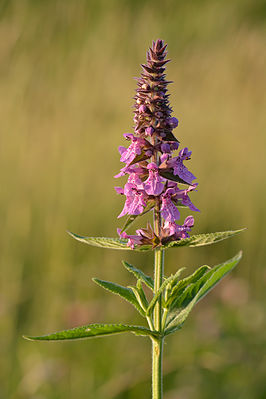Marsh Ziest
| Marsh Ziest | ||||||||||||
|---|---|---|---|---|---|---|---|---|---|---|---|---|

Swamp ziest ( Stachys palustris ) |
||||||||||||
| Systematics | ||||||||||||
|
||||||||||||
| Scientific name | ||||||||||||
| Stachys palustris | ||||||||||||
| L. |
The Stachys palustris ( Stachys palustris ) is a plant from the genus of Stachys ( Stachys ) in the family of Labiatae (Lamiaceae).
description
Appearance and foliage leaf
The marsh ziest grows as a deciduous, perennial herbaceous plant that usually reaches heights of 30 to 100 (rarely up to 120) cm. It forms subterranean runners with whitish tubers as persistence organs and their marrow serves as storage tissue. The rhizome-like tubers, which are thickened like a rosary at the nodes, are swellings at the ends of underground runners , as is the case with the very similarly structured potato tuber . The above-ground plant dies in autumn. In the following year, the axillary buds of the tuberous rhizome, which are used up, grow into new plants. The plant parts are almost odorless. The square stem is close to the body and particularly loosely protruding at the edges with silky hair.
The opposite leaves are quite narrow, lanceolate or oblong and somewhat heart-shaped at the bottom. The middle and upper leaves are sessile and more or less encompassing the stem, pale green, tomentose hairy to almost bare on both sides.
Inflorescence, flower and fruit
The flowering period is from June to September. There are four to ten flowers in each of the 10 to 20 (6 to 24) pseudo whorls . The hermaphrodite flowers are zygomorphic and five-fold with a double flower envelope and up to 1.5 cm long. There are five sepals. The five petals are fused into a corolla tube up to 9 mm long. The petals are cloudy red-violet with lighter serpentine markings, pink or light purple and often reddish mottled on the lower lip. The similar forest ziest is best recognized by its darker, almost burgundy-red flowers. The calyx teeth tower above the Klausen .
Chromosome number
The number of chromosomes is 2n = 64 or 102.
ecology
The marsh ziest is a tuber geophyte . Vegetative reproduction takes place abundantly through runners (see above). It has roots up to 60 centimeters deep.
In terms of blossom biology, it is a pre-male "actual lip flower of the Satureja type". The corolla tube has a hair ring as a "juice cover" that protects the nectar . The upper lip is short, the lower lip with line and dot markings. Because of the rich nectar secretion, the flowers are often visited by bees , butterflies and hoverflies . Spontaneous self-pollination is possible before blooming .
The fruits act as animal and wind spreaders; but possibly also as a dehydration spreader due to the calyx, which stands horizontally at maturity, initially enlarged but then shrunk. Swimming and spreading through agricultural implements are also possible. Fruit ripening occurs from July or August.
Occurrence
The marsh ziest is common in the temperate areas of Eurasia from Europe to Mongolia and the Himalayas. The marsh ziest grows in moist, nutrient-rich places such as on banks, next to water ditches or next to damp fields. It is a character species of the Filipendulion association, but also occurs as a soil silting pointer in societies of the Polygono-Chenopodion association and the Secalietea class. In the Allgäu Alps, it rises to an altitude of 1100 meters.
literature
- Henning Haeupler , Thomas Muer: picture atlas of the fern and flowering plants of Germany (= the fern and flowering plants of Germany. Volume 2). Published by the Federal Agency for Nature Conservation. Ulmer, Stuttgart 2000, ISBN 3-8001-3364-4 .
- Wolfgang Adler, Karl Oswald, Raimund Fischer: Excursion flora of Austria . Ed .: Manfred A. Fischer. Eugen Ulmer, Stuttgart / Vienna 1994, ISBN 3-8001-3461-6 .
- August Binz , Christian Heitz: School and excursion flora for Switzerland , Schwabe & Co. AG, Basel, 1986, ISBN 3-7965-0832-4
- Erich Oberdorfer : Plant-sociological excursion flora , Ulmer Verlag, Stuttgart, 1990, ISBN 3-8001-3454-3
- Konrad von Weihe (ed.): Illustrated flora. Germany and neighboring areas. Vascular cryptogams and flowering plants . Founded by August Garcke. 23rd edition. Paul Parey, Berlin / Hamburg 1972, ISBN 3-489-68034-0 .
- Ruprecht Düll , Herfried Kutzelnigg : Pocket dictionary of plants in Germany and neighboring countries. The most common Central European species in portrait . 7th, corrected and enlarged edition. Quelle & Meyer, Wiebelsheim 2011, ISBN 978-3-494-01424-1 .
Individual evidence
- ↑ a b c Erich Oberdorfer : Plant-sociological excursion flora for Germany and neighboring areas . With the collaboration of Angelika Schwabe and Theo Müller. 8th, heavily revised and expanded edition. Eugen Ulmer, Stuttgart (Hohenheim) 2001, ISBN 3-8001-3131-5 , pp. 807 .
- ↑ Erhard Dörr, Wolfgang Lippert : Flora of the Allgäu and its surroundings. Volume 2, IHW, Eching 2004, ISBN 3-930167-61-1 , p. 403.
Web links
- Marsh Ziest. In: FloraWeb.de.
- Marsh Ziest . In: BiolFlor, the database of biological-ecological characteristics of the flora of Germany.
- Stachys palustris L. In: Info Flora , the national data and information center for Swiss flora . Retrieved February 19, 2016.
- distribution
- Thomas Meyer: Ziest data sheet with identification key and photos at Flora-de: Flora von Deutschland (old name of the website: Flowers in Swabia )



